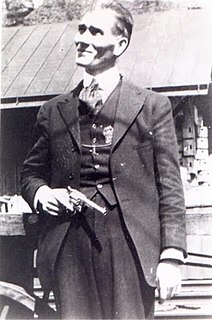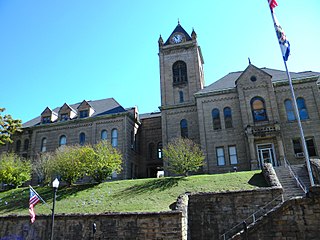
Mingo County is a county in the U.S. state of West Virginia. As of the 2010 census, the population was 26,839. Its county seat is Williamson. Created in 1895, Mingo is West Virginia's newest county, named for the historic Iroquoian Mingo people.

Thurmond is a town in Fayette County, West Virginia, United States, on the New River. The population was five at the 2010 census. During the heyday of coal mining in the New River Gorge, Thurmond was a prosperous town with a number of businesses and facilities for the Chesapeake and Ohio Railway. The town was the filming location for John Sayles' 1987 movie Matewan since it still possesses many of the characteristics of a 1920s Appalachian coal town.

Welch is a city located in McDowell County in the State of West Virginia, United States. The population was 2,406 at the 2010 census. Incorporated as a city in 1893, it is the county seat of McDowell County.

Matewan is a town in Mingo County, West Virginia, USA at the confluence of the Tug Fork River and Mate Creek. The population was 499 at the 2010 census. The Norfolk Southern Railway's Pocahontas District runs through the town.

The United Mine Workers of America is a North American labor union best known for representing coal miners. Today, the Union also represents health care workers, truck drivers, manufacturing workers and public employees in the United States and Canada. Although its main focus has always been on workers and their rights, the UMW of today also advocates for better roads, schools, and universal health care. By 2014, coal mining had largely shifted to open pit mines in Wyoming, and there were only 60,000 active coal miners. The UMW was left with 35,000 members, of whom 20,000 were coal miners, chiefly in underground mines in Kentucky and West Virginia. However it was responsible for pensions and medical benefits for 40,000 retired miners, and for 50,000 spouses and dependents.

Matewan is a 1987 American drama film written and directed by John Sayles, and starring Chris Cooper, James Earl Jones, Mary McDonnell and Will Oldham, with David Strathairn, Kevin Tighe and Gordon Clapp in supporting roles.
The Baldwin–Felts Detective Agency was a private detective agency in the United States from the early 1890s to 1937. Members of the agency were central actors in the events that led to the Battle of Blair Mountain in 1921 and violent confrontations with labor union members as part of the Coal Wars in such places as the Pocahontas Coalfield region of West Virginia, the Paint Creek-Cabin Creek strike of 1912 in West Virginia, 1913-1914 Colorado Coalfield War, and the Battle of Matewan in 1920.
The Battle of Matewan was a shootout in the town of Matewan in Mingo County and the Pocahontas Coalfield mining district, in southern West Virginia. It occurred on May 19, 1920 between local coal miners and the Baldwin–Felts Detective Agency.

The Battle of Blair Mountain was the largest labor uprising in United States history and the largest armed uprising since the American Civil War. The conflict occurred in Logan County, West Virginia, as part of the Coal Wars, a series of early-20th-century labor disputes in Appalachia. Up to 100 people were killed, and many more arrested. The United Mine Workers saw major declines in membership, but the long-term publicity led to some improvements in working conditions.

The Paint Creek–Cabin Creek Strike, or the Paint Creek Mine War, was a confrontation between striking coal miners and coal operators in Kanawha County, West Virginia, centered on the area enclosed by two streams, Paint Creek and Cabin Creek.

The West Virginia coal wars (1912–21), also known as the mine wars, arose out of a dispute between coal companies and miners.

William Sidney "Sid" Hatfield, was Police Chief of Matewan, West Virginia during the Battle of Matewan, a shootout that followed a series of evictions carried out by detectives from the Baldwin-Felts Detective Agency.

The first Jefferson County Courthouse was built in Charles Town, West Virginia, USA, in 1803, on a lot donated by Charles Washington. It was replaced by a larger building about 1836, which comprises the core of the present courthouse. The building is historically notable as the site of two trials for treason: that of John Brown in 1859, and those of unionizing coal miners from Mingo County, West Virginia, a consequence of the Battle of Blair Mountain, whose trials were moved from the southern part of the state in 1922 as a result of a change of venue.

The McDowell County Courthouse is a historic courthouse in Welch, West Virginia. It was placed on the National Register of Historic Places on August 29, 1979.

The Nuttallburg Coal Mining Complex and Town Historic District is located near Fayetteville, West Virginia in New River Gorge National River. The townsite is almost directly across from the Kay Moor mine and townsite, now abandoned. Like Kay Moor, the town is built around the railroad line at the bottom of the gorge, with an array of coke ovens and mining structures, as well as a bridge across the New River to South Nuttall.

Don Chafin was the sheriff of Logan County, West Virginia and a commander in the Battle of Blair Mountain. As sheriff of Logan County, Chafin was a fierce opponent of unionization and received hundreds of thousands of dollars from coal mine operators in return for his violent suppression of the United Mine Workers union.

William H. "Bill" Blizzard was a union organizer, a commander of the miners' army during the 1921 Battle of Blair Mountain, and president of District 17 of the United Mine Workers (UMWA). Blizzard is most remembered for his role in the Battle of Blair Mountain, leading the miners against the forces of Logan County sheriff Don Chafin. For his leadership role in the battle, Blizzard was charged with treason, but was acquitted at his trial on these charges. From that time forward, he remained an important leader within the UMWA and organized labor.

The Coal Wars were a series of armed labor conflicts in the United States, roughly between 1890 and 1930. Although they occurred mainly in the East, particularly in Appalachia, there was a significant amount of violence in Colorado after the turn of the century.
Charles Everett Lively (1887–1962) was a private detective affiliated with the Baldwin-Felts Detective Agency. He played an active role in the Coal Wars in Appalachia, and is chiefly remembered as one of the assassins of Police Chief Sid Hatfield.




















